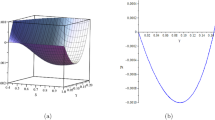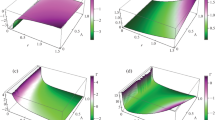Abstract
In this paper we formulate the problem of the collapse of a spherically-symmetric, radiating body in general relativity. The requirement that the metric and its normal derivative be continuous across the boundary imposes conditions upon the evolution of the star and allows identification of physical phenomena measured by a distant observer. A solution to Einstein's field equations for the exterior of a spherically-symmetric radiating body is that derived originally by Vaidya in 1951. By requiring the continuity described above we identify the mass, luminosity, velocity, and time increment measured by a distant observer in terms of the metric parameters evaluated in a frame comoving with the outer boundary. We also assume that the interior metric is a sum of products of functions of the radius and time. The continuity requirements allow the evolution of two of the three functions of time to be determined. The evolution of the third function, describing the motion of the core, is determined by the imposition of an equation of state at the center. The adiabatic index derived from the Baym-Bethe-Pethick equation of state was used to provide this last equation. A major result is obtaining an analytic solution to Einstein's field equations describing the core of a collapsing star. As a consequence of this solution we found that for the relatively small values of the adiabatic index (Γmax∼1.6), the star smoothly made the transition to a final collapsed state. Neither bounce nor shock wave was obtained. Also, there is a readily understood connection between the adiabatic index, and such parameters of the edge of the core as the velocity and acceleration. Finally, the analytic solutions provide the time-scales for the collapse which are significantly different from that of free-fall. The retarding effects of pressure upon the collapse are apparent. It is hoped that such analytic solutions will provide insight into more complicated dynamic systems in general relativity.
Similar content being viewed by others
References
Brill, D. R. and Cohen, J. M.: 1966,Phys. Rev. 143, 1011.
Chandrasekhar, S.: 1939,Introduction to the Theory ofStellar Structure, Dover, New York.
Cohen, J. M.: 1970,Int. J. Theor. Phys. 3, 207.
Colgate, S. A. and White, R. H.: 1966,Astrophys. J. 143, 626.
Landau, L. and Lifshitz, E. M.: 1971,The Classical Theory of Fields, 3rd ed., Addison-Wesley, Reading, Massachusetts.
Lindquist, R. W.: 1966,Ann. Phys. New York 37, 487.
Lindquist, R. W., Schwartz, R. A., and Misner, C. W.: 1965,Phys. Rev. B137, 1364.
Misner, C.: 1965,Phys. Rev. B137, 1360.
Schwarzschild, M.: 1958,Structure and Evolution of the Stars, Dover, New York.
Shapiro, S. L. and Teukolsky, S. K.: 1983,Black Holes, White Dwarfs, and Neutron Stars: The Physics of Compact Objects, Wiley-Interscience, New York.
Vaidya, P. C.: 1951,Proc. Indian Acad. Sci. 151, 659.
Author information
Authors and Affiliations
Rights and permissions
About this article
Cite this article
Adams, R.C., Cary, B.B. & Cohen, J.M. A simple model of a supernova. Astrophys Space Sci 155, 271–293 (1989). https://doi.org/10.1007/BF00643864
Received:
Accepted:
Issue Date:
DOI: https://doi.org/10.1007/BF00643864




